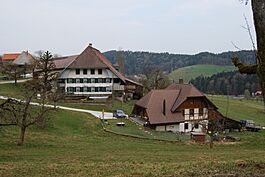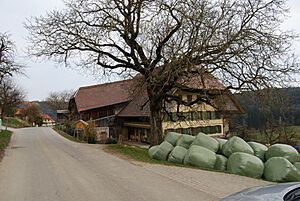Reisiswil facts for kids
Quick facts for kids
Reisiswil
|
||
|---|---|---|
 |
||
|
||
| Country | Switzerland | |
| Canton | Bern | |
| District | Oberaargau | |
| Area | ||
| • Total | 2.01 km2 (0.78 sq mi) | |
| Elevation | 645 m (2,116 ft) | |
| Population
(Dec 2020 )
|
||
| • Total | 173 | |
| • Density | 86.1/km2 (222.9/sq mi) | |
| Postal code |
4919
|
|
| Surrounded by | Gondiswil, Madiswil, Melchnau | |
Reisiswil is a small town, also called a municipality, in Switzerland. It's located in the Bern canton, which is like a state, within the Oberaargau administrative district.
Contents
History of Reisiswil
Reisiswil was first mentioned in old documents way back in 1194. Back then, it was called Richolsiswillare.
For a long time, Reisiswil was part of the lands owned by powerful families, the Counts of Langenstein-Grünenberg. In the 12th century, some land in the village was given to a place called St. Urban's Abbey. Another important group, the Abbey of St. Gall, also owned a lot of land here. The Counts of Grünenberg managed these properties for them.
When the Grünenberg family line ended in 1504, the city of Bern took over the village. Later, after the French invaded Switzerland in 1798, Reisiswil became part of the nearby municipality of Melchnau. But in 1815, it became its own independent municipality again.
During the 1800s, more people moved to Reisiswil. They found jobs making things like straw hats and spinning horse hair to earn extra money, alongside farming. However, in the 1900s, the population started to shrink. This happened because farming needed fewer people, and residents moved away to find other jobs. Even today, farming is still a very important part of the economy in Reisiswil.
Geography and Landscape
Reisiswil covers an area of about 2 square kilometers (0.77 square miles). A big part of this land, about 63.2%, is used for farming. Forests cover another 29.4% of the area. The rest of the land, about 5.0%, has buildings or roads on it. A very small part, 0.5%, is made up of rivers or lakes.
Most of the developed land is used for houses and other buildings. The forested areas are mostly dense, thick forests. For farming, about 29.4% of the land is used for growing crops, and 28.9% is used for pastures where animals graze. About 5.0% is used for orchards or vineyards. All the water in Reisiswil is from flowing rivers or streams.
The municipality is located in a hilly area within the Oberaargau region. The elevation, or height above sea level, in Reisiswil ranges from about 640 meters (2,100 feet) to 782 meters (2,566 feet). Reisiswil includes the main village and several smaller groups of houses called hamlets, such as Gstell, Gemeindeweid, and Adlihubel.
In 2010, Reisiswil became part of a new administrative district called Verwaltungskreis Oberaargau.
Reisiswil's Coat of Arms
The coat of arms for Reisiswil shows a silver shield with a black torch. The torch has red flames coming out of it and stands on a green hill with three small peaks. This design is called Argent a Torch Sable incensed Gules issuant from a Mount of 3 Coupeaux Vert.
Population and People
Reisiswil has a population of about 195 people as of 2010. Around 8.7% of these people are foreign nationals, meaning they are not Swiss citizens. Over the past ten years (2000-2010), the population has slightly decreased. This was mainly due to more people moving away than moving in.
Most people in Reisiswil speak German as their main language, about 95.4% of the population. A smaller number of people speak French (2.0%) or Albanian (1.0%).
As of 2008, about 48.7% of the population were male and 51.3% were female. Most residents were Swiss citizens. In 2000, about 42.1% of the people living in Reisiswil were also born there. Many others were born in the same canton (29.9%) or elsewhere in Switzerland (20.8%). Only a small percentage (6.1%) were born outside Switzerland.
In 2010, children and teenagers (ages 0-19) made up 23.6% of the population. Adults (ages 20-64) were the largest group at 61%, and seniors (over 64) made up 15.4%.
In 2000, there were 87 single people in Reisiswil who had never been married. There were 95 married people, 13 widows or widowers, and 2 divorced individuals.
The number of households with only one person was 21, and 10 households had five or more people. Most apartments (86.0%) were lived in all the time. A small number were used only during certain seasons (5.8%) or were empty (8.1%).
The chart below shows how Reisiswil's population has changed over many years:

Economy and Jobs
In 2011, Reisiswil had a very low unemployment rate of 0.68%. This means almost everyone who wanted a job had one. In 2008, there were 65 people working in the municipality.
- About 31 people worked in the primary economic sector, which includes jobs like farming and forestry. There were about 10 businesses in this sector.
- No one was employed in the secondary sector, which includes manufacturing and construction.
- About 34 people worked in the tertiary sector, which includes services. There were 10 businesses in this sector.
In 2008, there were 43 full-time equivalent jobs. This means if you add up all the hours worked, it's like 43 people working full-time. Most of these jobs (21) were in the primary sector, mainly farming. In the service sector, jobs included sales, transportation, hotels, restaurants, and technical professions.
In 2000, 5 workers came into Reisiswil for their jobs, while 48 workers left the municipality to work elsewhere. This shows that more people leave Reisiswil for work than come in. Most people (63.9%) used a private car to get to work, while a small number (2.1%) used public transportation.
Religion in Reisiswil
According to the 2000 census, most people in Reisiswil belonged to the Swiss Reformed Church, about 79.2%. About 5.1% were Roman Catholic. There were also people who belonged to other Christian churches (19.29%) and some who were Islamic (3.55%). A very small number of people were Hindu, had no religion, or did not answer the question.
Education and Schools
In Reisiswil, about 41.1% of the population has finished non-mandatory upper secondary education. This is like high school. About 5.1% have gone on to higher education, either at a university or a specialized college.
The school system in the Canton of Bern starts with one year of optional Kindergarten. After that, students go to six years of Primary school. Then, they have three years of mandatory lower Secondary school. In lower Secondary, students are grouped based on their abilities. After this, students can choose to continue their education or start an apprenticeship, which is like on-the-job training.
During the 2009–2010 school year, 10 students were attending kindergarten classes in Reisiswil. One of these students was a permanent or temporary resident of Switzerland but not a citizen.
In 2000, one student came to Reisiswil from another municipality to attend school. However, 4 students who lived in Reisiswil went to schools outside the municipality.
See also
 In Spanish: Reisiswil para niños
In Spanish: Reisiswil para niños








